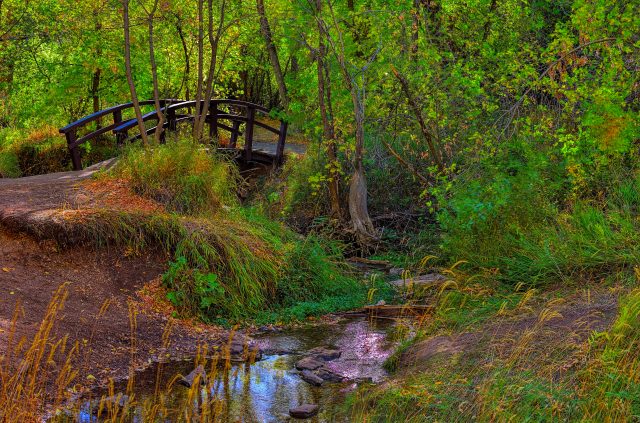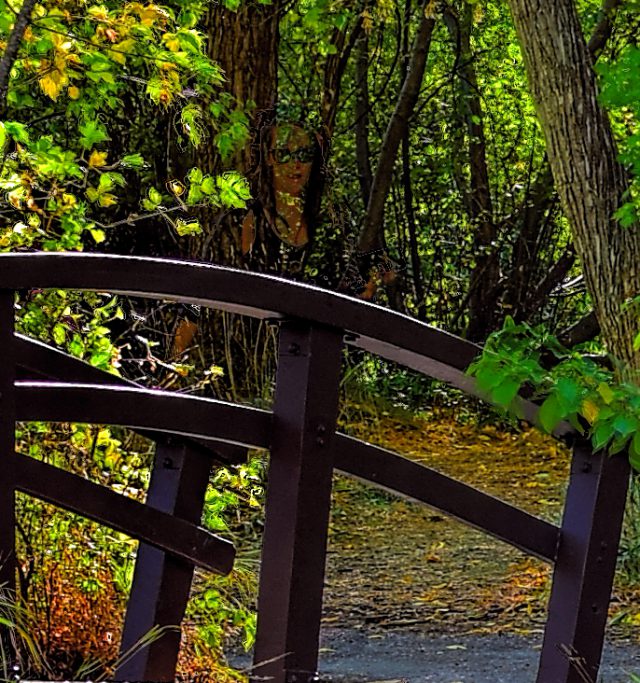PG went out looking for some autumn colors a couple of weeks ago. He didn’t find them in the usual places, but did find this spring that is the beginning of a small creek.

.
UPDATE – Sharp-eyed visitor Donna discovered a ghost in this photo. See the discussion in the comments.
Here’s an enlargement of a portion of the original image that shows the ghost.
.

Hi Donna Speare, I looked at the pic in detail, and could see nothing in the form you suggest. Can you be as specific as possible where you are seeing the form? This may be a case of the eyes matrixing a pattern.
Just above the first post in from the end on the near railing. That’s the post that’s in the middle of the gab in the grasses because of the stream.
So much more evident on the PC vs a phone.
Would you care to elaborate, PG, on the ghost in sunglasses — the shade in shades? — floating behind the bridge?
Donna – Congratulations on your excellent eye for detail.
For this photograph (and some others I have taken), I use a technique called HDR, an acronym for High Dynamic Range.
The reason for HDR is that the human eye can see a much wider range of light and darkness than a camera records in a single photo. The human eye can simultaneously see far more clear detail in the brightest parts of a scene and far more detail in the darkest parts of a scene than a camera can resolve at a single exposure setting.
This is the reason that sometimes a photo seems flat as compared with your memory of the subject of your photograph. Examples of this can be seen in some landscape photos taken in bright sunlight which include areas in shadow.
Your iPhone photo looking down into the Grand Canyon is a compromise between capturing the upper parts of the canyon in desert sunlight and the bottom of the canyon where the sun does not reach except for a short period of time in the middle of the day.
The photo above is a blending of five different photographs I took of the same scene.
A. Really over-exposed
B. Somewhat over-exposed
C. What the camera thinks is the correct exposure
D. Somewhat under-exposed
E. Really under-exposed
I then used HDR software to blend the various exposures together, using the portions of each photo that properly exposed the brightest and darkest parts of the scene in each of the five separate photos.
(The great American photographer, Ansel Adams, did the same thing in the darkroom, using his hands and various objects to reduce the time that some parts of the print were exposed to the bright light of the photo enlarger.)
One of the things that sometimes occurs between taking each of the multiple photos providing the basis of an HDR image is that things can move. Wind blowing leaves is one of the most common examples in landscape photographs. Each of the leaves in a photo is in a different position in each separate photograph. This can result in “ghosting” – faint images of the leaves in various windblown positions in the final image.
The HDR software that PG uses processes the final image in such a way that most, if not all, ghosting is eliminated (PG can increase or decrease this de-ghosting effect with a software setting).
When PG took the original five images that made up the final photo, there was just a tiny bit of wind blowing, so leaves were not much of a ghosting problem. The small stream at the bottom of photo was not changing much either and some ghosting in moving water can create a nice flowing effect.
However, PG was not alone when he was taking the original five photos. Other people were enjoying this lovely location, walking along a path that leads to the bridge in the photo.
PG was able to solve this problem (he thought) by having his camera mounted on a tripod and taking each of the five separate photos that were blended into the final image when no one was walking over the bridge or on the path leading to the bridge.
PG missed one person, however, that Donna saw and the deghosting software did not handle. He’s posted an enlargement of the ghost in sunglasses to everyone can see it below the OP. You can also see some artifacts of the hdr software correcting for slightly moving leaves.
Very cool! I didn’t know there was software that could do that.
I use Photomatix and have for several years, but there are also other HDR programs.
Thanks, PG. It is, as usual with your work, a striking photograph — and Miss Ghost makes it extra appropriate for this week.
I hadn’t thought about the timeliness of the ghost, Donna. I had not noticed her until you pointed her out.
Spooooooky!
Absolutely gorgeous! I’d love to see it on a book cover. Does Mrs. PG have a sylvan novel in the works?
Not so far, Deb.
I am not certain whether a good cover image should be the basis for a novel or not. 🙂
Very nice. And you know your Rule of Thirds! 😉
So beautiful, it is almost magical. Fantastic image!
Beautiful!